There’s a new boutique hotel in downtown Nashville and it’s brimful of art. The displays reach every corner of the converted historic building: there are exhibits in the lobby and corridors, throughout the basement and even in lifts and toilets. Created by whiskey heiress Laura Lee Brown and her husband Steve Wilson – who are entrepreneurial philanthropists, building preservationists and committed collectors of contemporary art – it’s called 21c Museum Hotel and is just that.
If you thought Nashville was only about music – country, rock and roll, blues, gospel, bluegrass, jazz – and its hotels were for sleeping between gigs, you thought wrong. Yes, the famous Grand Ole Opry country-music stage concert continues to crowd-please as it has since George D. Hay first aired his weekly radio barn-dance in 1925. Yes, the town centre’s old warehouse buildings throb with a cacophony of live performances from mid-morning until the early hours. Even the city’s murals and sculptures are of guitars. But there is another Nashville to enjoy between songs.
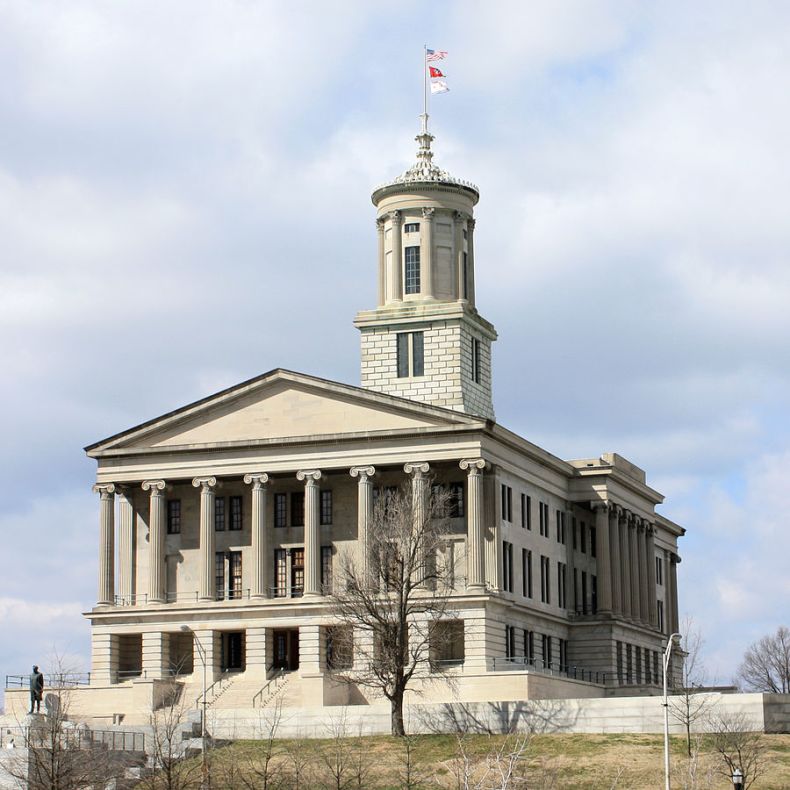
The Tennessee State Capitol in Nashville. Photo: Kaldari/Wikimedia Commons (used under public domain licence)
Nashville was founded in 1779 on the Cumberland River, just years after the pioneering ‘long hunters’ first crossed the Appalachian Mountains from the east, bringing back buckskins to trade at a dollar a piece (hence the dollar’s nickname). The city thrived as the trading hub for the agriculturally bountiful land of Tennessee state. While goods were shipped out, sophisticated ideas and luxury objects were shipped in. The city today is littered with historic buildings. William Strickland designed both the fine Greek Revival State Capitol (1859) and the Downtown Presbyterian Church (1851, with later decorative additions), considered one of the finest Egyptian Revival buildings anywhere. James Carpenter gave the city its Beaux-Arts Hermitage Hotel (1910) before going to New York where he designed about 40 of that city’s most notable apartment buildings. Some former public buildings have been re-purposed: Marr & Holman’s extravagant Art Deco post office building (1933–34), with a magnificent interior, is now the lively Frist Center for the Visual Arts. Some Nashville institutions have seen no demise: Hatch Show Print, whose signature bold letterpress posters have advertised Southern singers and events since 1879, still has busy working presses to visit.
Unusually for an American city, there are plenty of house museums. These include the formidable Adelicia Acklen’s antebellum mansion Belmont (1853); the Cheek family’s home and gardens, built in 1929 with the fortunes of Maxwell House Coffee, and recently restored; and the elegant nearby plantation houses Rippavilla, Belle Meade and Carnton. Three US presidents hail from Tennessee – Andrew Jackson (1829–37), James Polk (1845–49) and Andrew Johnson (1965–69). Jackson’s home, The Hermitage, is open to visitors.
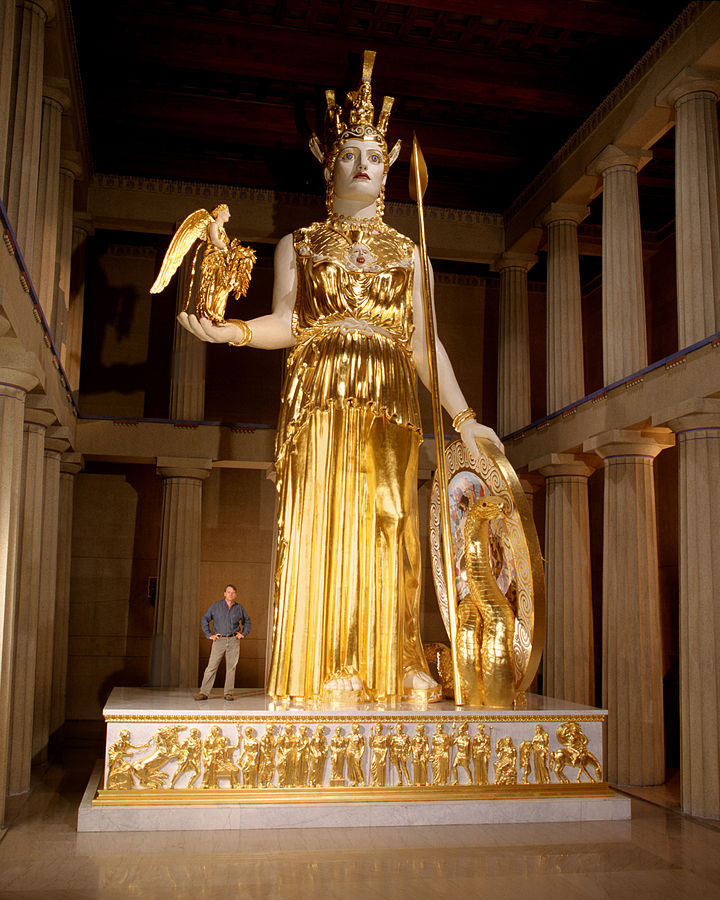
The lost Parthenon Athena statue, recreated by Alan LeQuire in 1990, is housed in a full-scale replica of the Parthenon in Centennial Park. Photo: Dean Dixon/Wikimedia Commons (used under Free Art License)
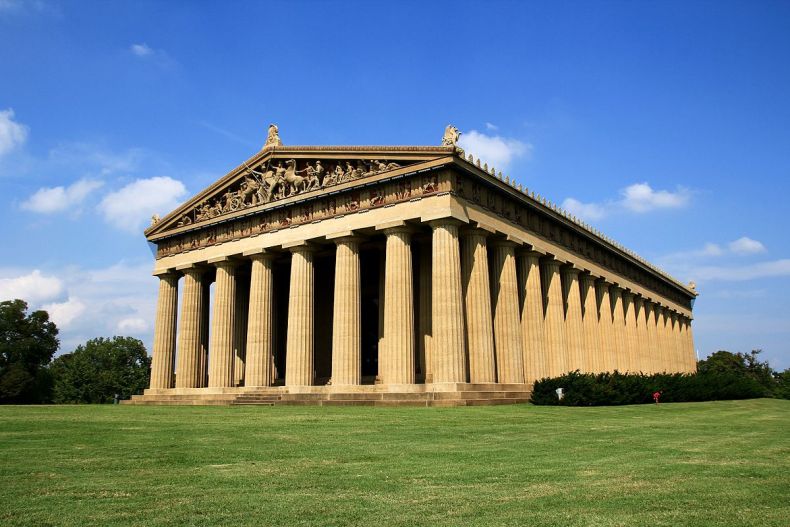
Nashville’s Centennial Park is home to a full-scale replica of the Parthenon. Photo: Mayur Phadtare/Wikimedia Commons (used under Creative Commons licence [CC. BY 3.0])
Perhaps Nashville’s most astounding building is a full-size replica of the Parthenon in Centennial Park, built in the 1920s to replace a popular temporary one created for the 1897 Tennessee Centennial Exposition, whose purpose was to show America and the world how the state had recovered from the ravages of the Civil War. The city even bought casts of the British Museum’s Elgin Statues for the local craftsmen to copy. Inside the temple, two exhibitions fill the basement, one about the Exposition, the other a group of 63 quality American pictures by the likes of William Merritt Chase and Thomas Moran, given by James M. Cowan. Undaunted by the loss of Phidias’s 5th-century BC sculpture from the original Parthenon many centuries ago, the city commissioned a 41-foot-tall, gilded statue of the goddess Athena to complete the replica.
So, there is more to Nashville than music. Brown and Wilson have made a shrewd decision to bring their innovative hotel model here, having successfully launched 21c Museum Hotels in other unlikely cities. They opened the first in their home town of Louisville in 2006, in a disused 19th-century tobacco and bourbon warehouse. Their double aim was to revitalise the inner urban neighbourhood, and to bring people into direct and informal contact with contemporary art. Hotels in Cincinnati (in the old Metropole Hotel adjoining the city’s museum), Bentonville (purpose-built near the Crystal Bridges Museum), Oklahoma City (in Albert Kahn’s Ford Motor Company Assembly Plant) and others followed. Nashville is the seventh, with Kansas City to open next year. So far, together they offer more than 75,000 square feet of exhibition space which is open to all. Their claim to be one of the largest contemporary art museums in the US is not far-fetched.
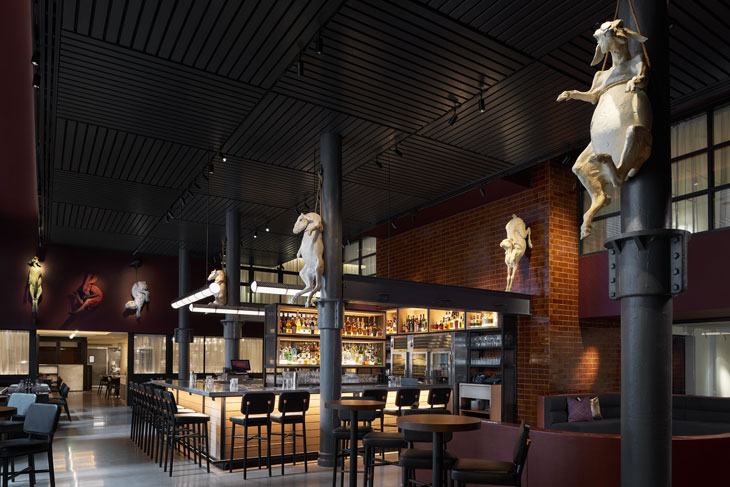
Spanish Feral Meat Goats and Emotions. Part of ‘Menagerie’ installed at Gray & Dudley Restaurant, 21c Museum Hotel Nashville. Photo: Mike Schwartz. Courtesy 21c Museum Hotels
The director and chief curator of the multi-venue 21c Museum is Alice Gray Stites. She oversees 18 staff and a collection of more than 3,000 works in all media – and she is busy. Working from Louisville, she oversees a lively change-around of exhibits at the hotels; she has curated more than 100 special exhibitions and commissioned 50 site-specific works. She has set up partnerships with major organisations such as MASS MoCA to reach out to artists globally. She makes time to travel with Brown and Wilson to Documenta, Art Basel and other major festivals to meet new artists and buy their work. She has built a strong relationship with the Grand Rapids ArtPrize, helping young artists from the 21c Museum Hotel cities to pitch their work. ‘You need to participate’, she says. ‘We want 21c to be part of the art conversation.’
‘I’ve noticed in these communities’, says Stites, ‘there is a hunger for what we are doing. I think our audiences are far more sophisticated and curious than perhaps we might assume them to be. Cutting-edge art should not be restricted to the coasts. What we put together is truly global.’ The Nashville hotel has two main inaugural shows. Beth Cavener Stichter’s large ceramic animal sculptures, which perch on the walls and eaves of the bar, explore connections between art and science. ‘Truth or Dare: A Reality Show’ fills the building’s basement with works by international artists including Mexican artist Pedro Reyes’s Lady Liberty (as Trojan horse) (2016) and Italian artist Federico Solmi’s The Good Samaritans (2015–16). As I visit it, people drift in from the bar, restaurant and street. They chat about some pieces, and stay on to explore more. I get the impression they will be back.
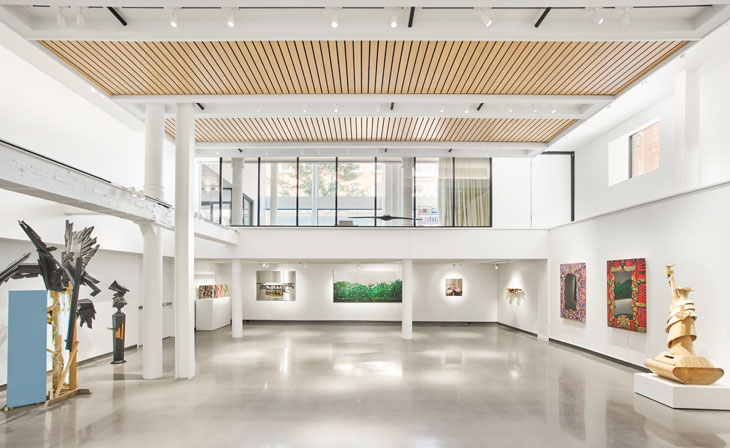
‘Truth or Dare: A Reality Show’ at the 21c Museum Hotel, Nashville. Photo: Mike Schwartz. Courtesy 21 Museum Hotels
For more about the 21c Museum Hotels, click here.
Unlimited access from just $16 every 3 months
Subscribe to get unlimited and exclusive access to the top art stories, interviews and exhibition reviews.


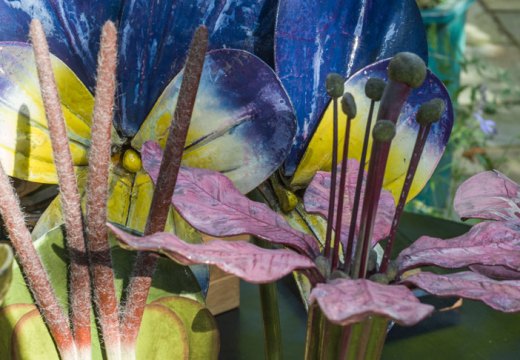

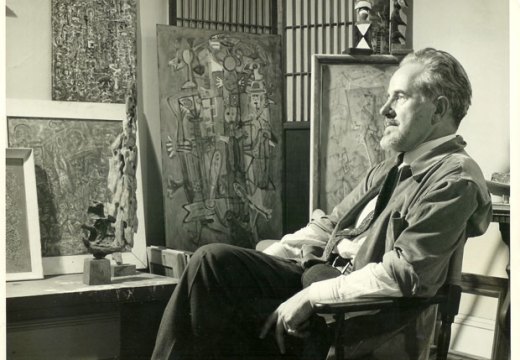









![Masterpiece [Re]discovery 2022. Photo: Ben Fisher Photography, courtesy of Masterpiece London](http://www.apollo-magazine.com/wp-content/uploads/2022/07/MPL2022_4263.jpg)
It’s time for the government of London to return to its rightful home